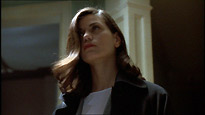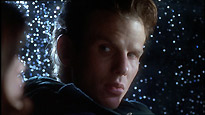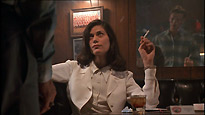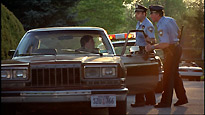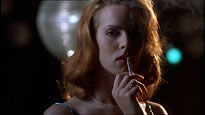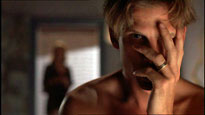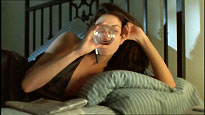|
THE LAST SEDUCTION - SPECIAL EDITION Region 2 (UK) Edition Director: John DahlStarring: Linda Fiorentino, Peter Berg, Bill Pullman, J.T. Walsh
BACKGROUND By the early 90s, the once-mighty ITC Entertainment Group, which - as Associated Television (ATV) - had once permeated ITV schedules with dozens of hit action and adventure series, was a shadow of its former self. The company had been splintered by the 1981 ITV franchise shake-up, and various boardroom power struggles. The main television production division, once home to perennially popular series like The Saint, Randall and Hopkirk (Deceased) and The Adventures of Robin Hood, had dwindled away. ITC's disastrous 1980 feature film adaptation of Clive Cussler's Raise The Titanic almost bankrupt the company, losing almost thirty million dollars. The film production division limped on through the 80s, with few notable commercial or critical hits (Sophie's Choice, On Golden Pond and The Company of Wolves all deserve a mention). No longer backed by steady income from their TV productions, the company's output turned increasingly to co-productions with American companies. Fortunately for ITC, sell-through home video was beginning to take hold, and exploiting their vast programme library was opening up a new revenue stream. However, it was too late, and the damage was done. Within a year or two ITC's library was bought by Dutch media giant Polygram, and ITC ceased to exist as anything more than a brand name. The Last Seduction was one of the last half dozen-or-so films to carry the ITC banner. THE MOVIE John Dahl's The Last Seduction is a classic film noir, about a woman who steals a bag full of cash, seduces a rube, and persuades him to kill her husband. Fiorentino plays Bridget Gregory, a clever, manipulative, sexual predator, succinctly described by one of her associates as a "self-serving bitch". She's the pit-bull supervisor in a telesales boiler room which ruthlessly peddles worthless commemorative coins to gullible punters. At the beginning of the film she's living with Clay Gregory (Bill Pullman), a medical student who has just sold a suitcase full of industrial-grade cocaine for a cool $700,000. In the heat of the moment he makes the mistake of striking her. Within hours she's vanished, and so has his money. She hides out in a "cow country" town, and there hooks up with cocksure young patsy Mike Swale (ER's Peter Berg), who's fled back home after a traumatic whirlwind romance. Mike quickly falls under Bridget's spell... but Clay, under pressure from loan sharks, is close on her trail... The film owes the lion's share of its reputation to Linda Fiorentino's incendiary Oscar-calibre performance. Confusing an actor with the character they play is a rookie mistake, but in this case, judging from the press she's received over the years, and the things that people who have worked with her have said (notably director Kevin Smith, in the supplements on the Dogma DVD), Linda Fiorentino is not far removed from Bridget Gregory. It is, however, worth noting that, although many have remarked that Fiorentino can be difficult to work with, Dahl chose her to star in his next film, the 1996 science-fiction tinged whodunit Unforgettable. Bill Pullman also gives a terrific performance. He may be one step behind Bridget for most of the movie, but, given how calculating she is, that's no mean feat. He's almost as sharp, and he knows Bridget well enough to guess her plans, and how to find her. Peter Berg, now a experienced and not untalented director in his own right, plays dumb convincingly. Good support is given by the late, great J.T. Walsh, as Bridget's ex-lover stroke lawyer stroke confidante, and Bill Nunn (Joseph Robertson in the Spider-Man series), as Harlan, the private investigator hired by Clay. When ITC green-lit the film, the company was expecting a Red Shoes Diaries-style soft-core erotic thriller. Dahl, who had directed two films not dissimilar to The Last Seduction, Red Rock West and Kill Me Again, delivered an art-house movie. Dahl was lucky in that he had very little interference from the studio: a change of management a week into production meant that the new regime had little inclination to get to grips with a project that was a couple of weeks away from completion. The film was made on a modest budget - about $2.5m. It's not flashy, or particularly sophisticated, but Dahl's direction is solid, lean and disciplined. Steve Barancik's sharp screenplay contributes wit and humour to the story, and some memorable, quotable dialogue. The cinematography, by Jeff Jur, is inventive, without drawing undue attention to itself. The jazzy, lolloping score, by Joseph Vitarelli, is well-suited, but rather repetitive. The film was screened on cable TV in the US, but given a theatrical release in the UK and in mainland Europe, where it met with considerable critical acclaim. This filtered back to the US, where a small independent distributor, October Films, licensed the film from ITC for a limited theatrical release (a similar thing happened to Dahl's Red Rock West). It was during its US theatrical run that Oscar buzz for Fiorentino's performance began building. Sadly, it was quickly stifled: the producers discovered that the film was ineligible for nomination, because it had premiered on television.
THE DVD The Last Seduction has been released several times on DVD, on both sides of the Atlantic. None of these has been very satisfactory. The most notable was the UK's 2001 Silver Classic edition, from Carlton. This had an anamorphic 1.78:1 transfer, but the only bonus feature was a trailer. This edition was re-packaged and re-released in 2004 by Prism Leisure. Network's new two-disc UK Region 2 edition renders all previous releases obsolete. The two disc set features the theatrical version of the film, with a new Dolby Digital 5.1 audio mix, on one disc, and a so-called Extended Director's Cut version of the film on the other. The extras - we'll come to those in a moment - are split across both discs. The theatrical version of the film (105'28") is presented in anamorphic 1.78:1 format, with an average bit-rate of 7.39Mb/sec. If it's not a new transfer, it's certainly a quite recent one, with very good detail, and realistic colour balance. Film Noir-style lighting predominates, and this doesn't translate easily to video, but where there lighting allows, the film looks very smart indeed. There's a touch of film sparkle (tiny white dots that appear for a single frame) here and there, but otherwise the print used is very clean and stable. The black levels are generally fine, and contrast is very good. The film has a nineties feel that no degree of restoration could remove, but that's only to be expected. There are no significant video or encoding faults. Framing generally seems fine, with the expected amount of headroom. There seems to be no question that the film was primarily intended to be seen in TV-style 4:3 format (although it's often been shown that way, of course). More on this later. The disc offers a choice of two audio tracks: a Dolby Digital 2.0 version (at 192kbps), which presumably replicates the original Ultra Stereo presentation, and a newly-created Dolby Digital 5.1 mix (at 448kbps). Both seem perfectly serviceable. The 5.1 mix offers an airier feel, and much better separation of music and dialogue. It's generally very nicely done, and doesn't sound completely artificial, like some 5.1 remixes. There's little surround presence in either version. Vitarelli's score often threatens to overwhelm the dialogue in the stereo version, and in this respect the 5.1 mix is preferable. There are no subtitles, and no player-generated on-screen captions (there are no on-screen captions at all).
BONUS MATERIAL DISC ONE The Art of Seduction is a by-the-numbers half-hour look at the film, chiefly comprised of talking head interviews and illustrative clips. The contributors are Dahl, Steve Barancik and Bill Pullman. Fiorentino and Berg make fleeting contributions courtesy of some contemporaneous EPK-style footage. The documentary is solid, but a lot of the information is repeated in the commentary. Perhaps the most surprising revelation is that Dahl had so much trouble finding someone who wanted to play Bridget: more than thirty actresses turned to role down. The lack of meaningful input from Fiorentino is disappointing, but not surprising. Behind-The-Scenes (9m) - this isn't mentioned on the sleeve. It's standard candid EPK B-roll footage. The audio is raw, and generally not properly mixed. There's a note explaining that the audio isn't of the best quality at the beginning, but that pretty much goes without saying, and is certainly par for the course. The footage focuses on about half a dozen scenes, and shows a brisk professionalism on the part of the cast and crew. It's interesting footage, and was certainly worth including on the disc. One of the shots shows the camera feed, which suggests the film was framed for 1.85:1 display, but protected for 4:3 presentation. The cheesy 1'37" Original Theatrical Trailer looks pale compared to the film. Presented in 4:3 format, you can immediately see many shots have superfluous headroom. Comparing them to the film transfer reveals - as expected - that the feature is cropped top-and-bottom. DISC TWO The second disc features the Extended Director's Cut version of the film, which runs for 128'45" (twenty-three minutes longer than the theatrical version). It's very unlikely that this is Dahl's preferred cut, so the title should be taken with a pinch of salt. The previously-deleted scenes have been taken from the only available source: a time-coded, rough-cut VHS that was kept by the director. Naturally this is of very poor quality compared to the film itself. The deleted scenes are dark, and very grainy (as part of the process of integrating them back into the film, they've been re-formatted to 16:9 ratio). They're also showered with film dirt and splice marks. You certainly wouldn't want to watch the whole film like this, but they're perfectly acceptable in this context. The Extended version of the film is presented with Dolby Digital 2.0 audio only. It has a much lower average bit-rate (4.10Mb/sec), despite also being on a DVD-9 disc. I'm no disc authoring expert, but this appears to be because there seems to be two versions of the film on the disc, one Extended Director's Cut, and another of the theatrical edition (with the deleted scenes tagged on to the end: Title 3 runs 2h53m18s (approximately the duration of the Extended Dirctor's Cut and the deleted scenes added together); Title 4 runs 2h08m48s (the duration of the Extended Director's Cut); and Title 5 runs for 57m16s (the deleted scenes on their own). Very odd. It matters little: fans of the film are likely to be spinning Disc One much more often than Disc Two. The Deleted Scenes can be accessed separately via a menu option. If you select this option, each deleted scene is presented in context, bracketed by (often excessively lengthy) clips from the film. This means to watch twenty-three minutes of deleted scenes, you have to watch fifty-seven minutes of material. I briefly toyed with the idea of detailing each and every deleted scene, but this review is probably long enough without that. Besides, frankly, some of them are pretty mundane, and describing them would contribute very little. Several of them involve Bridget (or Wendy, as she's calling herself at this point), at the Interstate Insurance Company, using the employees as an early warning system for signs that Clay's P.I. is getting close (the company's receptionist, briefly seen in the theatrical version, gains the most here, including a name: Alison). More significant is a thread showing Bridget / Wendy and Mike engaging in sexual role-playing games. This culminates in a scene where they break into a school gymnasium, where she memorably indulges his fantasies about a childhood crush. What a shame that this scene does not survive in pristine condition! This excised thread includes another bedroom scene between Mike and Bridget, where she teases him: "I'm a bad, bad girl... You ought to spank me, Mike.... Pretend I'm a nun..." This explains a line from Clay that remains in the film: "You're a very funny lady.. you know the role-play, eh? Baby, you make one hell of a horny nun!" It's worth noting that all the deleted footage appears in the first ninety minutes or so of the Extended version, leaving the last forty-minutes the same as the theatrical edition. The disc contains a final deleted treat: an Alternate Ending (5m), which is presented only as a separate menu item. SPOILERS AHEAD! This is an alternate version of the scene with Mike in prison talking to his lawyer. In this version, his lawyer is the J.T. Walsh character (Frank Griffith). Mike is unaware of Griffith's association with Bridget, and he recalls a piece of physical evidence that might support his version of events. Griffith relays this information to Bridget, who removes the evidence, sealing Mike's fate. Dahl explains that he suspected that this might be a twist too far, and so wisely shot the scene with another actor, too. The Extended Director's Cut and the Alternate Ending are accompanied by an optional commentary track by Dahl. It's not terribly engaging, but persevere and you'll find that the film is comprehensively dissected. The track is more about character motivations than the trivia of production. There are a few long gaps, but considering the film was made more than a decade ago, that's not terribly surprising. The final bonus is a good example of the sort of thing that Network does very well: finding some little related gem that might otherwise never see the light of day again. Finding these things is pretty easy, but having the dedication to locate and license them is not. Here it's an episode of the Showtime Networks cable TV series Fallen Angels (a.k.a. Perfect Crimes). It's an episode called Tomorrow I Die, which is based on a story by Mickey Spillane. It was originally transmitted in October 1995. It was directed by John Dahl, and features Last Seduction cast members Bill Pullman and Dean Norris (who play's Mike's buddy, Shep). This is perhaps not surprising, since Tomorrow I Die was cast by The Last Seduction's Debra Zane. There's another Dahl link, too: Kim Coates turns up in Unforgettable. Unfortunately Tomorrow I Die seems to be shorn of the Fallen Angels series opening titles, but it works perfectly well without them. Perhaps clearing the show's theme music was an additional expense that Network thought wasn't worth paying? Tomorrow I Die exhibits a few problems - sloppy audio sync, digital video noise reduction smearing, and signs of analogue tape instability. It's undoubtedly an old transfer. Fallen Angels was made by Propaganda Films, the company that produced Dahl's Kill Me Again and Red Rock West. The company also produced several projects with director David Lynch (including Wild at Heart, and Lynch's own anthology show, Hotel Room). Tellingly, Tomorrow I Die also features several luminaries from Lynch's Twin Peaks: Heather Graham, Jack Nance and Grace Zabriskie. The set comes with a twelve-page Collector's Booklet, which offers a feminist reading of the film by Dr Linda Ruth Williams, adapted from her book The Erotic Thriller in Contemporary Cinema. This is rather interesting, especially in light of the additional information we're given about Linda and Mike's relationship in the deleted scenes, which Williams wasn't privy to. The essay is illustrated with a handful of photo's from the film. SUMMARY The Last Seduction is a cracking movie, with an outstanding lead performance. Network's transfer is virtually flawless, with good picture and audio quality. The set offers fans of the film an excellent package of bonus material, including a director's commentary track, and numerous deleted scenes (including one of the all-time great deleted scenes!) An essential purchase for fans of 90s cinema, film noir movies, and fans of Linda Fiorentino.
|



